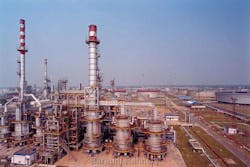State-owned Indian Oil Corp. Ltd. (IOC) is moving forward with its previously announced project to increase crude oil processing capacity at the company’s 6 million-tonne/year (tpy) Barauni refinery in Begusarai District, Bihar (OGJ Online, Aug. 11, 2015).
At a Jan. 30 meeting, the company’s board approved an estimated investment of 137.79 billion rupees (±10%) for a project to expand crude processing capacity by 3 million tpy to 9 million tpy and adding downstream polymer units at the Barauni refinery, IOC said in a Jan. 31 filing to the National Stock Exchange of India Ltd.
Designed to help meet growing domestic demand for petroleum products in India, the Barauni crude processing capacity expansion is currently scheduled for commissioning by April 2023, IOC said.
IOC’s board previous approval of the Baruni capacity expansion in 2016 estimated overall project cost at 82.87 billion rupees (OGJ Online, Sept. 30, 2016).
Proposed project details
According to the latest project documents available from IOC, India’s Ministry of Environment, Forest, and Climate Change (EFCC), and Envirotech East Pvt. Ltd.—which completed the project’s environmental impact assessment study in November 2018—the Barauni capacity expansion will include construction of a new 9 million-tpy atmospheric and vacuum distillation unit (AVU) to replace the refinery’s three existing AVUs, which will be idled.
The expansion project also will involve revamps and upgrades to increase capacity of current units at the refinery, including:
- Expanding the refinery’s existing 210,000-tpy naphtha hydrotreating (NHDT) and catalytic reforming combined capacity to 300,000 tpy.
- Expanding capacity of the existing 1.4 million-tpy residue fluid catalytic cracking unit to 1.7 million tpy.
- Expanding capacity of the existing 500,000-tpy Coker B to 662,000 tpy.
The project also entails installation of major grassroots units, including:
- Two new sulfur recovery units, each with a capacity of 80 tonnes/day.
- A new 304,000-tpy isomerization unit.
- A new 360,000-tpy NHDT unit designed to treat naphtha feed moving specifically to the isomerization unit.
- A new 1.2 million-tpy diesel hydrotreating unit.
- A new 61,000-tpy hydrogen generation unit.
- A new 1 million-tpy once-through hydrocracking unit.
- A new 562,000-tpy propylene recovery unit.
- A new 200,000-tpy polypropylene (PP) unit.
- A new 390,000-tpy LPG treatment unit.
- A new 880,000-tpy naphtha splitting unit.
- A new 500-tonnes/hr amine recovery unit.
- A new 220-tonnes/hr sour water stripping unit.
- A new 6,178-kg/hr flue gas amine treating unit.
IOC already let a contract to McDermott International Inc. to provide technology licensing, basic engineering design, and catalyst the proposed 200,000-tpy PP unit to be added as part of the capacity expansion project (OGJ Online, Jan. 4, 2019).
About the Author
Robert Brelsford
Downstream Editor
Robert Brelsford joined Oil & Gas Journal in October 2013 as downstream technology editor after 8 years as a crude oil price and news reporter on spot crude transactions at the US Gulf Coast, West Coast, Canadian, and Latin American markets. He holds a BA (2000) in English from Rice University and an MS (2003) in education and social policy from Northwestern University.

